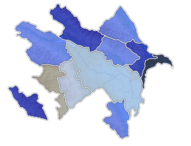
KNOWPIA
WELCOME TO KNOWPIA
Summary
This is a list of Azerbaijani regions by Human Development Index as of 2021.[1] This also includes Baku, the capital and largest city, but excludes the Nakhchivan Autonomous Republic and Kalbajar-Lachin.

>0.800
0.750 – 0.800
0.700 – 0.750
0.650 – 0.700
| Rank | Region | HDI (2021) |
|---|---|---|
| Very high human development | ||
| 1 | Baku | 0.814 |
| High human development | ||
| 2 | Absheron Economic Region (without Baku) | 0.789 |
| 3 | Nakhchivan Autonomous Republic | 0.756 (2017) |
| 4 | Sheki-Zagatala economic-geographical region | 0.751 |
| – | 0.745 | |
| 5 | Guba-Khachmaz Economic Region | 0.723 |
| 6 | Mountainous Shirvan Economic Region | 0.712 |
| 7 | Ganja-Gazakh Economic Region | 0.709 |
| 8 | Lankaran Economic Region | 0.704 |
| Medium human development | ||
| 10 | Aran Economic Region | 0.698 |
| 11 | Yukhari-Karabakh economic region | 0.691 |
| – | Kalbajar-Lachin | No data |
Nakhchivan Autonomous Republic edit
Nakhchivan enjoys a high Human Development Index; its socio-economic prowess far exceeds that of Azerbaijan itself. According to the report of Nakhchivan AR Committee of Statistics on June 30, 2018 for the end of 2017, some socio-economical data, including the following, are unveiled:
| Variable | Value |
|---|---|
| Population | 462,055[2] |
| GNI (PPP) per capita | $15,240[3] |
| Life Expectancy at birth | 72.9 years[4] |
| Mean Years of Schooling | 10.5 years[5] |
| Expected Years of Schooling | 12.6 years[5] |
Making use of the Human Development Index calculation method according to the new UNHD 2014 method,[6] the above values change into these:
References edit
- ^ "Sub-national HDI - Area Database - Global Data Lab". hdi.globaldatalab.org.
- ^ "Naxçıvan əhalisinin sayı açıqlandı". 22 May 2018. Retrieved 23 January 2018 – via qafqazinfo.az.
- ^ "Makroiqtisadi göstəricilər". statistika.nmr.az. Retrieved 2014-12-05.
- ^ "Naxçıvan Muxtar Respublikası üzrə cins bölgüsündə doğulanda gözlənilən ömür uzunluğu". Retrieved 2014-12-05.
- ^ a b "Naxçıvan Muxtar Respublikası üzrə təhsilin əsas göstəriciləri". Retrieved 2014-12-05.
- ^ "Technical notes: Calculating the human development indices – graphical presentation" (PDF). 24 June 2014. Retrieved 2014-12-05.


